Last Updated on January 6, 2024 by Greg Gillson
When selecting binoculars for bird watching, you may be tempted to look at high magnification binoculars. This article tells you why that might not be a good idea. You want to select the best magnification for your bird watching style.
The best magnification for general bird watching binoculars is 8x (8-power).
Other magnification ranges may be appropriate for you, depending upon they type of bird watching you do–both the species you observe and the locations where you usually watch birds.
What size binoculars are good for bird watching?
A good size for bird watching binoculars are ones with 7x to 10x (“7 to 10 power magnification”). But the magnification is only one part of the equation.
The other important variable needed to answer this question is the size of the objective lens (“the big end”). These two things determine the size, weight, light gathering ability, field of view, cost, and your ability to hold the binoculars steady. There are several tradeoffs to magnification and objective lens size.
My first pair of binoculars (actually my father’s “sporting goods store brand”) was a 7×35 (“seven by thirty-five”). It magnified 7 times and had objective lenses of 35 millimeters.
When I was able to afford my first pair of binoculars, I did what many beginning birders do. I bought a pair of 10x binoculars. 10×50. Fifty millimeter objective lenses are big…and heavy.
The size of the objective lens determines how much light your binoculars will gather, thus how bright the image appears. Larger objective lenses allow you to bird in overcast conditions, dark woods, and twilight.
As a rule of thumb, full-sized birding binoculars should have a ratio of 1:5 magnification to size of objective lens. Thus, 7×35, 8×40, and 10×50 all have that 1 to 5 ratio, and are common binocular sizes.
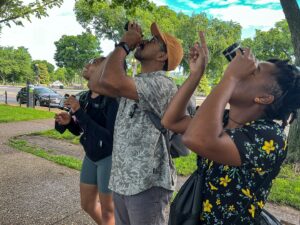
This ratio (objective lens diameter divided by magnification) is called exit pupil. This published spec allows you to determine generally how bright the image will be when light levels are low.
Binoculars of 8×42 are somewhat brighter than this standard ratio. Other popular birding binoculars of 10×42 and 8×32 are significantly dimmer than this standard ratio. Rather, they are fine in bright light but give a dimmer display when light levels are lower.
The larger objective lenses make the binoculars heavier. Heavy binoculars are harder to hold steady and become wearisome after hours in the field.
This unsteadiness is exacerbated with more magnification. The shakiness of your hand will create a shaky image. And 10x binoculars will have image shake almost 1/3 more than a 7x binocular, if they weighed the same. But they don’t. The 10x binocular is heavier and will cause additional shakiness as the day wears on.
Greater magnification reduces field of view. Field of view is how wide of an angle your binoculars capture.
A wide field of view helps you “get on” a bird flying overhead more easily.
Think of a narrow field of view as looking through a straw to find the bird.
Field of view on binoculars is measured as linear feet of width at 1000 yards distance. Thus, binoculars that show an image 330 feet wide at 1000 yards are considered on the narrow end of field of view. Binoculars that show an image 440 feet wide at 1000 yards have a very wide field of view and are very desirable.
Two other specifications of binoculars are important for bird watchers.
If you wear eyeglasses, you’ll want binoculars with longer eye relief. Eye relief of 15.5 to 20 millimeters is good for eyeglass wearers. Within that range, longer is better.
Bird watchers may view birds in woods at close range. They often also enjoy viewing butterflies and dragonflies. If this describes you, then look for binoculars with close focus of less than 8 feet, perhaps down to 6 feet.
 |
| My recommended bird watching kit with my 8×42 binoculars |
8×42 (“eight by forty-two”) is the best size binoculars for bird watching
Most birders choose 8×42 binoculars as their binocular of choice.
8-power magnification brings even distant birds into view. Yet they are small and light enough that they can be held steady without undue arm fatigue.
The exit pupil of 5.25 mm (objective lens diameter of 42 mm divided by magnification of 8) means that this binocular is quite bright in even dim light. This is perfect for walking in the woods at dawn or under overcast morning skies.
8x binoculars also tend to have an inherently wider field of view than 10x binoculars. So you are able to scan more area and find birds off of the center view.
What about 8×20 or 8×25 compact binoculars for bird watching?
Compact binoculars of 8×20 or 8×25 are good for close birds in bright daylight. But they are too dim for some birding situations, such as dusk, woods, or overcast days.
Compact binoculars are those with the normal magnification (7x to 10x) but with smaller objective lenses of less than 30 millimeters. They are much lighter and some fold down to fit easily into a pocket, purse or backpack.
Their small size may be suitable for some children or adults with smaller hands.
But because the exit pupil is less than 5mm (2.5mm for 8×20 and 3.125mm for 8×25) they will be noticeably dimmer in low light. They will be great under sunlit skies. They will give a darker display in the morning gloom or under the canopy of trees. So they are not the best choice for general-purpose everyday binoculars.
These are suitable for a “second pair” of binoculars you may always keep in the car. They may be fine for watching birds at your feeder out your window. They are a great backpacking binocular. The 8×25 binoculars are better in low light than the 8×20.
Something to research: 8×32 mid-sized binoculars for birding
8×32 binoculars may be good for bird watching under certain conditions.
The mid-sized 8×32 binoculars are a good compromise between the full-size 8×42 and the smaller compact 8×25 binoculars.
For one thing, the 8×32 binoculars often have the same eyepieces (ocular lenses) and prisms as the larger 8×42 binoculars. Thus, they often have much better specs than the compact binoculars, which require smaller prisms.
They are lighter in weight and have a smaller form factor than full-sized binoculars. So they have many of the benefits of the smaller compact binoculars.
The exit pupil is 4.0mm. They will be bright in most birding circumstances. But you will notice they are dimmer in low light in a side-by-side comparison with an 8×42 binocular of the same model.
The 8×32 mid-sized binocular could be a good choice for someone with smaller hands or who wanted a lighter-weight pair of binoculars but didn’t want to give up too much optical quality of most compact binoculars.

Are 10×42 binoculars good for bird watching?
10×42 binoculars are the second best choice for bird watching binoculars, especially if most of your bird watching is done in open country for more distant birds.
We’ve already discussed how 10x magnification binoculars have a narrower field of view, are slightly darker in dim light (exit pupil of 4.2mm), and magnify your arm shake.
However, they also magnify the bird’s size by 25% over the 8x binocular. That is not insignificant.
If you have strong, steady, arms you may consider a 10×42 binocular as your primary birding binocular.
10x binoculars are especially good for open country birding. If you primarily watch more distant birds in good light, then these might be a better choice for you. If your birding consists primarily of watching ducks, hawks, and shorebirds, then these are your bins.
However, you may consider a spotting scope for this type of birding, allowing for 25-60x magnification.
Are 10×50 binoculars good for birding?
10×50 binoculars are a bit too heavy for general bird watching, and have some other drawbacks.
I had this size binocular for several years as a young man. They have a bright 5.0mm exit pupil for excellent brightness in dim light. They are significantly heavier, though. And mine were poro prism design (not waterproof). [Some poro prism binoculars are waterproof, while most roof prism binoculars are.] The waterproof roof prism design would be even heavier than my old 10×50 poros.
The close focus distance is generally not close in these binoculars. They may not have good eye relief, either.
Can they work for birding? Yes. Would I recommend 10×50 binoculars for bird watching? No.
Are 10×25 binoculars good for bird watching?
No, 10×25 binoculars are not good for bird watching.
The 2.5mm exit pupil is unacceptably dim.
The field of view will be terribly narrow, making the arm shake even more noticeable.
I can’t recommend 10×25 binoculars for birding. If I saw a bird and these were the only binoculars available then, sure, I’d lift them to my eyes. But I wouldn’t have them as my primary birding binoculars.
Are 12x binoculars good for bird watching? 15x?
No, 12x and 15x binoculars are not good for bird watching.
For all the reasons 10x are difficult, anything more becomes unusable. If you want more magnification than 10x then you need to look into purchasing a spotting scope with a sturdy tripod. Spotting scopes generally range from a magnification of 20 to 60x.

Wrapping Up
- The 8×42 binocular is the best magnification for bird watching under the widest variety of conditions.
- The 8×25 compact binocular is good for bird watching on a backpacking trip or as a second pair to carry in your car’s glove compartment.
- The 10×42 can be a good bird watching binocular if you have steady arms and (though we didn’t discuss it) if you don’t wear eyeglasses.
- The mid-sized 8×32 or 10×32 can be a nice compromise between full-sized and compact binoculars.
Frequently Asked Questions
What does 10×50 mean in binoculars?
1. Magnification: The first number, 10x, refers to the magnification power. This means that objects will appear 10 times closer through the binoculars than they would to the naked eye. So, an object 100 meters away would appear 10 meters away through the binoculars.
2. Objective Lens Diameter: The second number, 50mm, refers to the diameter of the objective lenses in millimeters. These are the large lenses at the front of the binoculars that gather light. Larger objective lenses allow more light to enter the binoculars, resulting in brighter images, especially in low-light conditions.
Therefore, 10×50 binoculars offer 10x magnification with 50mm objective lenses. This combination is generally considered a good all-purpose choice for users who prioritize both powerful magnification for distant objects and good light gathering for viewing in various lighting conditions.
How is a scope different from binoculars?
Here’s a breakdown of the key differences between scopes and binoculars:
Design:
- Binoculars: Designed for handheld use, with two eyepieces for comfortable viewing using both eyes.
- Scopes: Typically designed with a single eyepiece, often requiring a tripod or other support for stable viewing.
Magnification:
- Binoculars: Commonly offer magnifications ranging from 8x to 12x.
- Scopes: Usually have higher magnifications, starting from 15x and going up to 60x or more.
Field of View:
- Binoculars: Provide a wider field of view, allowing you to see a larger area at once.
- Scopes: Have a much narrower field of view, focusing on a smaller area in more detail.
Focusing:
- Binoculars: Typically have a central focusing knob and may have individual eyepiece adjustments.
- Scopes: Often have separate focus knobs for coarse and fine adjustments to achieve sharp images.
Portability:
- Binoculars: Compact and lightweight, making them easy to carry and use on the go.
- Scopes: Larger, heavier, and more cumbersome to transport, often requiring a carrying case or backpack.
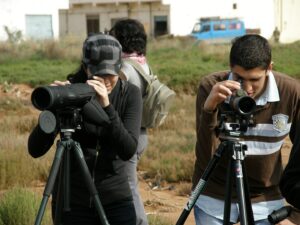
Is a scope better than binoculars for bird watching?
Whether a scope or binoculars are better for birdwatching depends on your specific needs and the birding experience you’re aiming for. Both have their advantages and disadvantages:
Binoculars:
Pros:
- Portable and versatile: Easy to carry, use, and adjust on the go, making them ideal for exploring trails and scanning broad areas.
- Wider field of view: Allows you to see more of the surrounding environment and spot moving birds quickly.
- Good for general observation: Perfect for observing behavior, interactions, and identifying birds at closer distances.
- More comfortable for extended use: Easier to hold and use for longer periods compared to a scope.
Cons:
- Lower magnification: Typically offer lower magnification than scopes, making it harder to see tiny details on distant birds.
- Less light gathering: May struggle in low-light conditions, resulting in dimmer images.
- Not ideal for extreme long-range viewing: Difficult to see extremely distant birds with clarity.
Scopes:
Pros:
- Higher magnification: Can bring distant birds much closer, revealing details like plumage patterns and subtle markings.
- Better light gathering: Often equipped with larger objective lenses, providing brighter images in low light.
- Ideal for detailed observation: Perfect for studying specific birds, examining features, and observing behavior close-up.
Cons:
- Bulky and cumbersome: Can be heavy and inconvenient to carry and adjust in the field.
- Narrow field of view: Makes it harder to scan large areas and spot moving birds quickly.
- Requires stable setup: Needs a tripod or other support for optimal viewing, limiting flexibility.
- Less comfortable for extended use: Can be tiring to hold and look through for long periods.
________________________________________________________________________________________________
Related Articles:
The Celestron Nature DX ED 8×42 binocular is an excellent budget-priced binocular for beginning bird watchers. Check out my in-depth review.
Bird Watching Basics (series): How to start watching birds



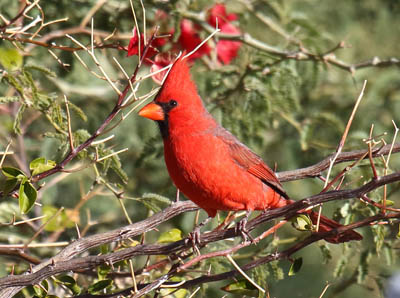
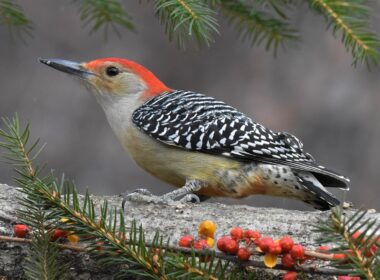
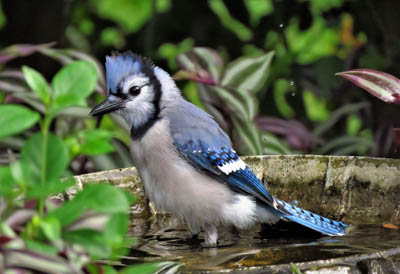
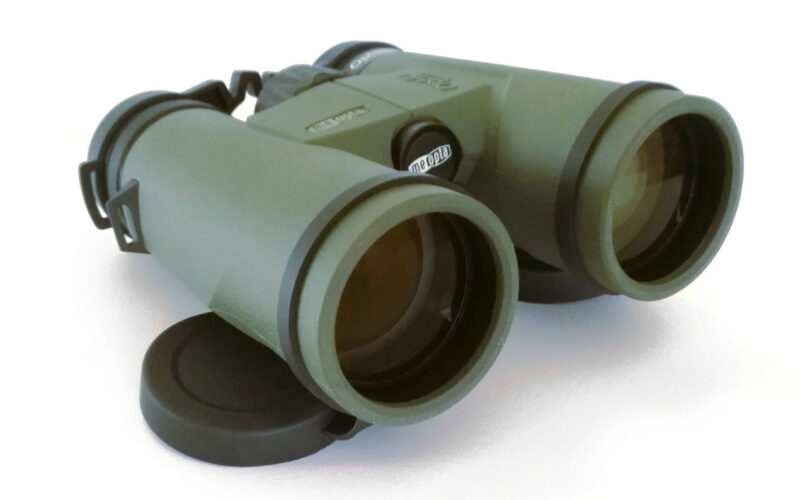
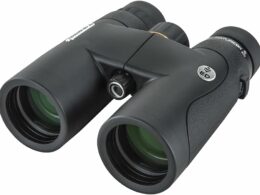
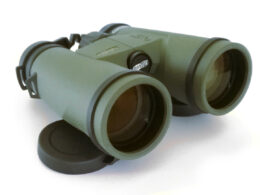
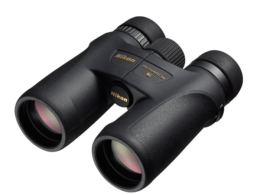
This is a well written article that clearly explains the pros and cons of different binocular configurations. A must read for anyone contemplating the purchase of binoculars for birding.
Thank you! Very, very kind. You use my typical sentence structure and vocabulary. I'm sure some people will think I wrote this comment myself!
Very glad I found your article. I have been looking for the right binoculars for years. I finally know what to shop
for! Thanks much
years. Now I know what to shop for!
You are welcome! I tried to simplify it so bird watchers would know exactly what to look for.
Great article. I had been looking a different binoculars, and knew about the 5X guideline, but the tips on Weight and Field of view will help me make my final decisions..
Thanks. I'm so glad this was helpful for you!
This is very simple written article. Just a basic standard information about binoculars without many consideration, you can find anywhere.
First of all, there is no information about what distance birding binoculars work the best.
Second, assertion of importance, that difference of field of view between binoculars with 8x, 10x, 12x for birding is absolutely irrelevant. You want to see birds up close in details from whatever distance binocular magnification allows you, but not a flock of birds. So difference between 400ft and 300ft FV at 1000 yards away is absolutely unimportant. And BTW, you never observe birds from such long distance anyway. 1000 yards away is for ship or airplane spotting, but not for birds. 100 yards or less is OK and the best is less than 50 yards.
Third, about binocular magnification. If you watching object 100 yards away with 8x, 10x, 12x magnification binoculars, you won't see any difference in details between them, just slight magnification in more powerful one and a bit more clarity on the one with less. But within 50 yards you will definitely find that details are more enjoyable using 12x binocular. Stability (shaking) within that distance won't be detrimental for 12x bino. Having all these three sizes binoculars, I happened to be using 12x the most. Not 12×50, but 12×42, which is not so common, but very comfortable, about the same size and weight as 10x or 8x.
Pred,
You obviously have a different opinion than mine. That's okay.
I don't think beginners should use 12x or even 10x binoculars. 8x is good. 7x is good.
I think you misunderstand about the specification of field of view. Just because the manufacturer's numerical comparison is made at 1000 yards, doesn't mean that that is the distance you use them.
Field of view is a cone from the objective lens out to infinity. It can also be given as degrees.
1 degree = 52.5 feet at 1000 yards. I think the latter is easier to understand. I was keeping it simple on purpose to be understood by many.
The difference between 325 and 440 feet at 1000 yards (narrow versus wide field of view), is the difference between 3.3 feet and 4.4 feet viewing width at 10 feet. That's huge! You could easily miss a bird in the tree tops or bushes that hops. Thus, wider field of view is usually more desirable.
I'm not the only one that thinks that 8x is better.
The Cornell Lab of Ornithology's blog for bird watchers has this page on choosing binoculars:
https://www.allaboutbirds.org/news/six-steps-to-choosing-a-pair-of-binoculars-youll-love/
"In general 10x are better at distance birding. But it usually also means a narrower field of view, a slightly darker image in low light, and more noticeable hand-shake. An 8x gives you a smaller image that’s wider, brighter, and easier for finding and following birds."
"The best magnification for bird watching binoculars is 8x (8-power)"
That's the statement you started your article with. Does it mention "beginners"?
"Beginners" is very moot point. For how long after people start birding you consider them beginners?
Its always evolving experience, people get used to it and start looking for improvement. And that's what I offered them to consider in my above comment.
I have no problem with the 8x or 10x power binos for beginners. That was not my point. I discover something about 12×42, and I share it.
Your warning about difference FoV of 8x, 10 or even 12x is overstated. Give me an example when its matter. The only difference between FoV is matter when you compare binoculars and spotting scopes. That's huge.
"In general 10x are better at distance birding."
Or 12x? I guess it meant "longer" distance, right? Read my comment again. The power of 10x or 12x would be better actually for a shorter distance, the one that you feel comfortable with 8x.
You'll get more details noticeable and it wont be much shaking.
Once again, birding is for birds, not for nature spotting forest, river or mountain, and above mentioned FoV differences are not important.
Thanks for you reply Greg.
P.S. My opinion is not different from yours, you just didn't exceed it beyond the basics and applied to different situations for birding needs as I did.
P.S#2. 8x is most universal power for binoculars, applicable for many situation. For example, for sports, where its FoV would be important, because you need to see a play, not a wrinkle of individual player..
Thanks for sharing your viewpoint. You have several valid arguments.
There are 3 situations where I have observed that a larger field of view is desirable.
It is just such reasons that I recommend a new birder choose their first pair of binoculars carefully, weighing magnification, eye relief, brightness, and field of view, waterproofing, and price.
1) New bird watchers who don't have a lot of experience using binoculars.
When leading bird watching walks and tours, I've noticed that some people have trouble "getting on" a bird. Perhaps a high-flying hawk or swift in the sky, perhaps a flycatcher sitting in the canopy of a tree, perhaps a distant petrel flying among the waves. These people have trouble finding the bird or putting their binoculars right on the bird with the first time. They may scan around and give up.
Wide field of view allows them to find birds even if they didn't point binoculars dead center on the bird. As they gain more experience using binoculars, their skill pinpointing the birds and bringing them into view improves.
2) Following moving birds in brush or tree canopy.
Every spring the warblers, vireos, tanagers, and flycatchers migrate in waves through the tree tops. Many fly-hop from branch to branch, in 3-6 feet jumps. I really appreciate having wide field of view so that I can follow the birds without them hopping out of the frame of view and getting lost to me.
3) Scanning among flocks of mixed birds.
I often glass a flock of ducks, shorebirds, and gulls, searching for one that is different to find something rare. I can do this with binoculars with a wide field of view. I can't jump from bird to bird as easily with a narrow field of view–I miss too many outliers.
For me, who often birds at dawn with overcast skies and/or in the woods, brightness is the most important aspect of binoculars, then sharpness, followed by field of view, and then magnification.
If I primarily bird watched in the prairie or shoreline, I'd want more magnification to bring more distant birds into view.
I believe this discussion will be useful to those looking to purchase binoculars. Thank you!
This comment has been removed by the author.
u brought so much perspective!! I'm struggling on finding binoculars for me. for my bird watching, since it's distance birding, the 10×50 binoculars would be great. fully multi coated, 7.5 angle, and suitable for astronomy. the specs are generally better than the other model I'm debating on. it's 8×42, aluminizing coating, 6.3 angle. but, I'm worried cause the eyecups for the 10x model is fold-down (eye relief 23mm) would this be of relevance?? what are the pros and cons? is it better or worse than the other model (twist-up, 20.4mm)?
another thing is, I'm very excited and looking forward to using my binoculars to look at clouds. and I'm worried the 10×50 would be too much magnification. both for this specific activity, and for general use.
I could really use ur opinion and informed words abt this!!
Good questions, erinacomanado!
First, birding binoculars are not often good for astronomy. Useable for occasional looking at the moon or 4 larger moons of Jupiter, but the day-time versus night-time use require different lenses and optical properties. You need to research "astronomy binoculars." I do not have that information immediately available.
Rubber eyecups fold up and down and can wear out IF you regularly share binoculars between a person who wears eyeglasses and one who does not. Eyecups out (extended) if no eye glasses; if you wear eyeglasses then you fold the eyecups down or twist the eyecups in. You LEAVE THEM THAT WAY unless you share binoculars, as stated.
Eye relief of 23mm is longer than any I've seen (15-21mm is typical, longer better in this range; much shorter and you cannot use eyeglasses without losing field of view). At 23mm you'll have the eyecups out, perhaps even with glasses. At that distance, I'd be worried that without eyeglasses you'd have to hold the binoculars too far away from your eyes so you don't get those black circles.
Twist eye cups often have intermediate indents, allowing up to 5 positions. Rubber fold-down eyecups are just up or down.
Without trying them, I'd worry about the 23mm rubber fold-down eyecups not matching your eyes when up or down.
THANK U SM FOR THE QUICK RESPONSE. the 10x binoculars are actually astronomy binoculars. i'm not very certain how birding works, at what distance is 8x magnification usable? i have a bit of distance from the mangrove forest, one i'm planning on observing most. and i'm worried i'm too far out to be able to use the 8x bi. for watching birds
I use 8x for general bird watching at all distances.
For ducks and hawks and open country birds 10x is probably better.
I use a spotting scope for hard-to-identify shorebirds over 200 feet away, ducks farther, and seabirds up to 1-1/2 miles. But these are extreme.
This was the best most inclusive and easy to understand article on binoculars I have ever read. Thank you..for the first time I actually understand what to look for when selecting my new pair of binoculars. Well done!!
Oh, wonderful!
Thank you for this! I was lucky enough to be gifted 10×42 binoculars and decided to start birding to put them to good use. I have yet to use any other binoculars. Early on, I definitely noticed the arm-shake and struggled with field of vision, but I have since gotten used to them and my arms seem to have steadied. I'm sure enjoying them!
What a wonderful gift!